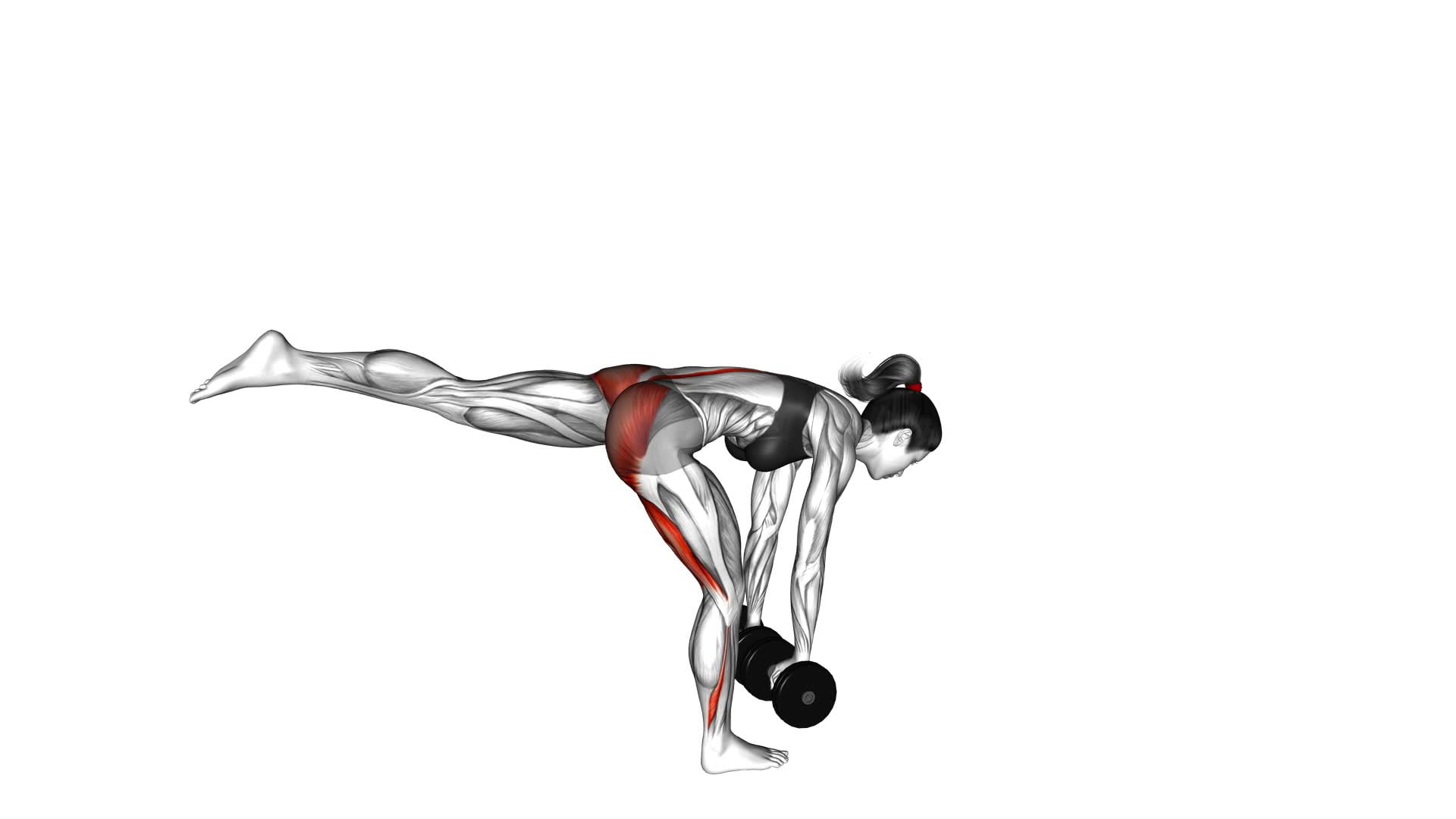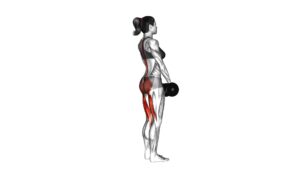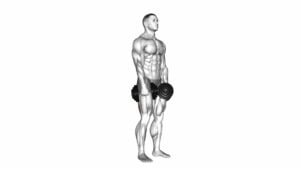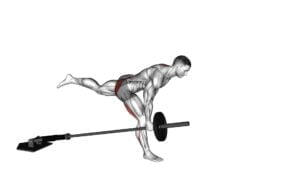Dumbbell Single Stiff Leg Deadlift (female) – Video Exercise Guide & Tips

Are you looking for a challenging and effective exercise to strengthen your lower body? Look no further than the dumbbell single stiff leg deadlift.
Watch This Exercise Video
This exercise targets your hamstrings, glutes, and core while improving your balance and stability.
In this video exercise guide, we'll show you the proper form and technique, tips for choosing the right weight and equipment, common mistakes to avoid, modifications and progressions, and tips to improve your performance.
Get ready to take your fitness to the next level.
Key Takeaways
- The Dumbbell Single Stiff Leg Deadlift targets hamstrings, glutes, and core.
- Proper form and technique involve standing with feet hip-width apart, hinging forward at the hips while keeping a straight back, and lifting one leg straight back in line with the torso.
- Common mistakes to avoid include rounding the back, allowing the knee to bend too much, lifting the leg too high, and neglecting proper form and control.
- Modifications and progressions for this exercise include adjusting the weight of dumbbells, using a resistance band for added difficulty, starting with lighter weights and gradually increasing, and focusing on maintaining proper form throughout.
Benefits of the Dumbbell Single Stiff Leg Deadlift
To get the most out of the Dumbbell Single Stiff Leg Deadlift, you'll experience several benefits. This exercise is highly effective in building muscle and improving balance. By incorporating the Dumbbell Single Stiff Leg Deadlift into your fitness routine, you'll target and strengthen various muscles in your lower body, including your hamstrings, glutes, and lower back. This exercise engages these muscle groups in a unilateral manner, meaning each leg is worked independently, which helps to correct muscle imbalances and promote symmetry.
Furthermore, the Dumbbell Single Stiff Leg Deadlift also challenges your core stability and proprioception, which plays a vital role in improving your overall balance. As you perform the exercise, you must maintain proper form and control throughout the movement, requiring you to engage your core muscles to stabilize your body. This not only strengthens your core but also enhances your proprioceptive awareness, allowing you to better control your body's movements and maintain balance in various activities and sports.
Incorporating the Dumbbell Single Stiff Leg Deadlift into your workout routine won't only help you build muscle but also improve your balance, stability, and overall physical performance.
Proper Form and Technique
To perform the Dumbbell Single Stiff Leg Deadlift with proper form and technique, follow these steps:
- Start by standing with your feet hip-width apart and holding a dumbbell in each hand.
- Engage your core and keep your back straight as you hinge forward at the hips.
- Lift your right leg straight back behind you, keeping it in line with your torso, and lower your upper body towards the floor.
- As you lower, allow your arms to hang straight down towards the floor, keeping a slight bend in your knees.
- Pause for a moment when you feel a stretch in your hamstrings and glutes, then slowly return to the starting position.
- Repeat the movement on the opposite leg.
Common mistakes to avoid when performing the Dumbbell Single Stiff Leg Deadlift include rounding your back, allowing your knee to bend too much, or lifting your leg too high. Make sure to keep your back straight and your leg in line with your torso throughout the movement.
Modifications and progressions for the Dumbbell Single Stiff Leg Deadlift can be made by adjusting the weight of the dumbbells or using a resistance band for added difficulty. Remember to start with lighter weights and gradually increase as you become more comfortable with the exercise.
Choosing the Right Weight and Equipment
When selecting the appropriate weight and equipment for the Dumbbell Single Stiff Leg Deadlift, consider using dumbbells that are suitable for your strength level and a resistance band for added challenge. Proper equipment selection is crucial to ensure that you can perform the exercise safely and effectively.
For the Dumbbell Single Stiff Leg Deadlift, you'll need a pair of dumbbells. Start with a weight that allows you to maintain proper form throughout the exercise. As you become stronger and more comfortable with the movement, you can gradually increase the weight for progression. It's important to choose a weight that challenges you without compromising your technique.
Additionally, incorporating a resistance band can provide an extra level of difficulty by adding resistance to the movement. This can help to further strengthen your muscles and improve your balance. By selecting the right weight and equipment, you can maximize the benefits of the Dumbbell Single Stiff Leg Deadlift.
Now, let's move on to the next section and discuss some common mistakes to avoid.
Common Mistakes to Avoid
When performing the dumbbell single stiff leg deadlift, it's important to avoid common mistakes that can hinder your progress and increase the risk of injury.
One common mistake to avoid is incorrect hip alignment, which can put strain on your lower back and diminish the effectiveness of the exercise.
Another mistake is rounded back posture, which can lead to poor form and potential back pain.
Lastly, neglecting proper form, such as not keeping your core engaged and shoulders back, can compromise the stability and effectiveness of the exercise.
Incorrect Hip Alignment
You need to ensure that your hip alignment is correct when performing the dumbbell single stiff leg deadlift. Incorrect hip alignment can lead to various issues, including decreased effectiveness of the exercise and potential injuries.
Here are three important tips to help you correct your hip alignment and prevent injuries:
- Maintain a neutral spine: Keep your back straight throughout the movement, avoiding excessive rounding or arching. This helps align your hips properly and reduces strain on your lower back.
- Engage your core muscles: Activate your core by drawing your belly button towards your spine. This stabilizes your pelvis and maintains proper alignment of your hips during the exercise.
- Balance your weight evenly: Distribute your body weight evenly between both legs. This ensures that your hips stay aligned and prevents any excessive tilting or leaning to one side.
By following these hip alignment correction tips, you can perform the dumbbell single stiff leg deadlift safely and effectively.
Now, let's discuss the next common mistake to avoid: rounded back posture.
Rounded Back Posture
Maintain proper posture to prevent rounded back during the dumbbell single stiff leg deadlift. Rounded back posture is a common mistake that can lead to muscle imbalances and increased risk of injury.
When performing this exercise, it's crucial to keep your back straight and engage your core muscles. Rounded back exercises, such as the single stiff leg deadlift, can help improve posture by strengthening the muscles in your back and core. By focusing on maintaining a neutral spine throughout the exercise, you can avoid rounding your back and promote proper alignment.
Neglecting proper form and allowing your back to round can put unnecessary strain on your spine and compromise the effectiveness of the exercise. So, remember to prioritize proper posture and form to maximize the benefits of the dumbbell single stiff leg deadlift.
Neglecting Proper Form
To avoid neglecting proper form during the dumbbell single stiff leg deadlift, it's important to focus on maintaining a neutral spine and engaging the core muscles. Improper technique can increase the risk of injury and prevent you from getting the full benefits of the exercise.
Here are three common mistakes to avoid:
- Rounding your back: Keep your back straight throughout the movement to protect your spine and avoid straining your lower back.
- Not engaging your core: Your core muscles play a crucial role in stabilizing your body during the exercise. Make sure to activate your core by drawing your belly button in towards your spine.
- Using too much weight: It's essential to choose a weight that allows you to maintain proper form. Using excessive weight can compromise your technique and increase the risk of injury.
Modifications and Progressions
To modify and progress the dumbbell single stiff leg deadlift exercise, consider incorporating variations that challenge different muscle groups and increase difficulty levels.
One modification you can try is the single leg Romanian deadlift, where you perform the exercise with only one leg while keeping the other leg lifted off the ground. This variation increases the stability and balance challenge, while also targeting the hamstrings, glutes, and lower back.
Another modification is to increase the weight of the dumbbells used. This adds more resistance and makes the exercise more challenging for the muscles involved. Gradually increase the weight as you become stronger and more comfortable with the movement.
To further progress the exercise, you can try performing it on an unstable surface, such as a Bosu ball or a balance board. This adds an extra element of instability, forcing your muscles to work harder to maintain balance and control.
Additionally, you can incorporate a tempo change by slowing down the lowering phase of the exercise. This increases the time under tension for your muscles and intensifies the workout.
Remember to always prioritize proper form and technique when modifying or progressing the dumbbell single stiff leg deadlift exercise. Start with modifications that suit your current fitness level and gradually progress as you become stronger and more confident.
Tips to Improve Your Performance
To improve your performance in the dumbbell single stiff leg deadlift, there are several key points to keep in mind.
First, focus on maintaining proper form techniques throughout the exercise, ensuring that your back stays straight and your core remains engaged.
Additionally, pay attention to your breathing, inhaling as you lower the dumbbell and exhaling as you come back up.
Lastly, consistently challenge yourself by gradually increasing the weight of the dumbbell to build muscle strength and enhance your overall performance.
Proper Form Techniques
Improve your performance by focusing on maintaining a strong and stable stance during the dumbbell single stiff leg deadlift. Proper form techniques are essential for building muscle mass and preventing injuries. Here are three tips to help you perform this exercise effectively:
- Keep your core engaged: To maintain stability and prevent injury, engage your core throughout the movement. This will help you maintain proper alignment and protect your lower back.
- Maintain a neutral spine: Avoid rounding or arching your back during the exercise. Keep your spine in a neutral position to ensure proper form and minimize stress on your back.
- Control the movement: Slowly lower the dumbbell towards the ground while keeping your leg straight. Focus on using your glutes and hamstrings to lift your body back up to the starting position. Controlling the movement will maximize the effectiveness of the exercise and reduce the risk of injury.
Breathing During Exercise
As you focus on maintaining proper form techniques during the dumbbell single stiff leg deadlift, it's crucial to pay attention to your breathing for improved performance. Proper breathing technique can help you maintain stability and control throughout the exercise.
When performing the dumbbell single stiff leg deadlift, inhale as you lower the dumbbell towards the ground, and exhale as you come back up to the starting position. This inhale and exhale pattern will help you engage your core muscles and maintain balance.
By coordinating your breath with your movements, you can enhance your overall strength and endurance during the exercise.
Now that you understand the importance of breathing during the dumbbell single stiff leg deadlift, let's explore how to further build muscle strength.
Building Muscle Strength
You can consistently increase your muscle strength by incorporating targeted exercises into your routine. Here are three tips to help you improve your performance and achieve your muscle building goals:
- Progressive Overload: Gradually increase the intensity of your workouts by adding more weight, increasing repetitions, or reducing rest periods. This will challenge your muscles and stimulate growth.
- Compound Exercises: Focus on compound movements that engage multiple muscle groups, such as squats, deadlifts, and bench presses. These exercises allow you to lift heavier weights and stimulate more muscle fibers, leading to greater strength gains.
- Proper Nutrition: Fuel your body with a balanced diet that includes adequate protein, carbohydrates, and healthy fats. Protein is essential for muscle repair and growth, while carbohydrates provide energy for intense workouts.
Incorporating strength training into your fitness routine can help you build muscle and improve overall strength and performance.
Frequently Asked Questions
Can Men Also Perform the Dumbbell Single Stiff Leg Deadlift Exercise?
Yes, men can also perform the dumbbell single stiff leg deadlift exercise.
To modify the exercise for men, you can increase the weight of the dumbbells used.
Additionally, if you find it difficult to maintain balance, you can perform the exercise with a slight bend in your knee.
Alternatively, you can try other exercises such as the barbell deadlift or the Romanian deadlift to target similar muscle groups.
How Many Sets and Repetitions Should I Do for Maximum Benefits?
For maximum benefits, you should consider the number of sets and repetitions when performing the Dumbbell Single Stiff Leg Deadlift exercise.
The ideal number of sets and repetitions may vary depending on your fitness level and goals.
It's generally recommended to start with 2-3 sets of 8-12 repetitions.
However, you can modify and adjust the sets and repetitions to challenge yourself or accommodate any limitations.
Consulting with a fitness professional can provide you with personalized variations and modifications for this exercise.
Is It Necessary to Warm up Before Performing the Dumbbell Single Stiff Leg Deadlift?
Before performing the dumbbell single stiff leg deadlift, it's necessary to warm up.
Incorporating a warm up routine before this exercise offers several benefits, such as increasing blood flow to the muscles, improving flexibility, and reducing the risk of injury.
It also helps to prepare your body for the physical demands of the exercise.
Additionally, warming up can help you avoid common mistakes like using improper form or overloading the weight, leading to better overall performance and results.
Can I Use a Kettlebell Instead of a Dumbbell for This Exercise?
Yes, you can use a kettlebell instead of a dumbbell for the single stiff leg deadlift. This exercise allows for variations and modifications, giving you the flexibility to use different equipment.
However, it's important to note that the benefits of using a dumbbell for this exercise include better grip and stability.
The choice between dumbbell and kettlebell ultimately depends on your personal preference and fitness goals. Experiment with both to see which works best for you.
Are There Any Specific Breathing Techniques to Follow During the Exercise?
During the exercise, it's important to focus on your breathing technique. Take a deep breath in as you lower the dumbbell or kettlebell down towards the floor, and exhale as you come back up. This will help stabilize your core and maintain proper form.
If you're a beginner, you can modify the exercise by using lighter weights or starting with bodyweight only. Remember to listen to your body and go at your own pace.
Conclusion
In conclusion, the dumbbell single stiff leg deadlift is a highly effective exercise for targeting the glutes, hamstrings, and lower back.
By maintaining proper form and technique, choosing the appropriate weight, and avoiding common mistakes, you can maximize the benefits of this exercise.
Additionally, modifications and progressions can be implemented to cater to different fitness levels.
By following these tips and continuously improving your performance, you can achieve great results with the dumbbell single stiff leg deadlift.

Author
Years ago, the spark of my life’s passion ignited in my mind the moment I stepped into the local gym for the first time. The inaugural bead of perspiration, the initial endeavor, the very first surge of endorphins, and a sense of pride that washed over me post-workout marked the beginning of my deep-seated interest in strength sports, fitness, and sports nutrition. This very curiosity blossomed rapidly into a profound fascination, propelling me to earn a Master’s degree in Physical Education from the Academy of Physical Education in Krakow, followed by a Sports Manager diploma from the Jagiellonian University. My journey of growth led me to gain more specialized qualifications, such as being a certified personal trainer with a focus on sports dietetics, a lifeguard, and an instructor for wellness and corrective gymnastics. Theoretical knowledge paired seamlessly with practical experience, reinforcing my belief that the transformation of individuals under my guidance was also a reflection of my personal growth. This belief holds true even today. Each day, I strive to push the boundaries and explore new realms. These realms gently elevate me to greater heights. The unique combination of passion for my field and the continuous quest for growth fuels my drive to break new ground.



